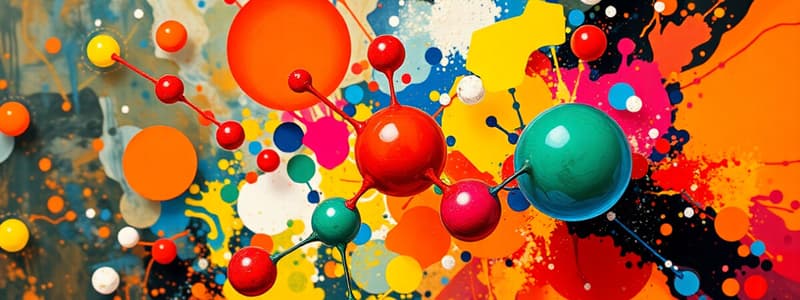Podcast
Questions and Answers
Which state of matter has a fixed shape and volume?
Which state of matter has a fixed shape and volume?
- Plasma
- Solid (correct)
- Gas
- Liquid
What occurs during the process of condensation?
What occurs during the process of condensation?
- Gas turns into liquid (correct)
- Solid turns into liquid
- Solid turns directly into gas
- Liquid turns into gas
Which factor generally increases the kinetic energy of molecules?
Which factor generally increases the kinetic energy of molecules?
- Increasing temperature (correct)
- Decreasing volume
- Decreasing temperature
- Increasing pressure
What type of solids have a highly ordered structure?
What type of solids have a highly ordered structure?
What is the process called when a solid transitions directly to a gas?
What is the process called when a solid transitions directly to a gas?
Which of the following states of matter have weak intermolecular forces?
Which of the following states of matter have weak intermolecular forces?
What is the energy required to change one gram of solid to liquid at its melting point called?
What is the energy required to change one gram of solid to liquid at its melting point called?
What do phase diagrams graphically represent?
What do phase diagrams graphically represent?
Which transition involves the absorption of energy?
Which transition involves the absorption of energy?
What characteristic is true for gases compared to solids and liquids?
What characteristic is true for gases compared to solids and liquids?
Flashcards
Solid
Solid
A state of matter with a fixed shape and volume. The molecules are tightly packed and have strong interactions.
Liquid
Liquid
A state of matter with a definite volume but takes the shape of its container. Molecules are less tightly packed than solids and flow easily.
Gas
Gas
A state of matter with no fixed shape or volume. The molecules are widely spaced and move rapidly.
Melting
Melting
Signup and view all the flashcards
Freezing
Freezing
Signup and view all the flashcards
Vaporization
Vaporization
Signup and view all the flashcards
Condensation
Condensation
Signup and view all the flashcards
Sublimation
Sublimation
Signup and view all the flashcards
Deposition
Deposition
Signup and view all the flashcards
Phase Diagram
Phase Diagram
Signup and view all the flashcards
Study Notes
Introduction to States of Matter
- Matter exists in various physical states, primarily solid, liquid, and gas.
- These states differ in their molecular arrangement, energy, and properties.
- The change between states involves energy transfer and often a change in the arrangement of molecules.
Solid State
- Solids maintain a fixed shape and volume.
- Molecules in a solid are tightly packed and have strong intermolecular forces.
- Solids generally have a high density and are rigid.
- Crystalline solids have a highly ordered structure, while amorphous solids do not.
Liquid State
- Liquids have a definite volume but adapt to the shape of their container.
- Molecules in a liquid are less tightly packed than in a solid, with weaker intermolecular forces.
- Liquids have a moderate density compared to solids and gases.
- Liquid particles can flow and diffuse.
Gaseous State
- Gases have neither a fixed shape nor a fixed volume.
- Molecules in a gas are widely spaced and have weak intermolecular forces.
- Gases have a low density and expand to fill their container.
- Gas particles move randomly and rapidly.
Changes of State
- Melting: Transition from solid to liquid, absorbing energy.
- Freezing: Transition from liquid to solid, releasing energy.
- Vaporization: Transition from liquid to gas, absorbing energy (evaporation or boiling).
- Condensation: Transition from gas to liquid, releasing energy.
- Sublimation: Transition from solid directly to gas, absorbing energy (example: dry ice).
- Deposition: Transition from gas directly to solid, releasing energy (example: frost formation).
Factors Affecting Changes of State
- Temperature: Increasing temperature generally increases kinetic energy of molecules, driving the transition from solid to liquid to gas.
- Pressure: High pressure can hinder the transition from liquid to gas or solid to liquid.
- Intermolecular Forces: Stronger intermolecular forces require more energy to overcome and transition between states.
- Heat of Fusion: Energy required to change one gram of solid to liquid at its melting point.
- Heat of Vaporization: Energy needed to change one gram of liquid to gas at its boiling point.
Phase Diagrams
- Phase diagrams graphically represent the conditions of temperature and pressure at which different states of matter are stable.
- Phase diagrams show the phase transitions that occur under different conditions.
- The triple point is the point where all three states coexist in equilibrium.
- The critical point is the temperature and pressure above which the liquid and gas phases become indistinguishable.
Applications of State Changes
- Many industrial processes rely on phase transitions (e.g., steam power generation, refrigeration).
- Understanding phase changes is crucial in various scientific and engineering fields, such as materials science, chemistry, and physics.
- Phase transitions are fundamental to the behavior of many materials and substances in natural settings, such as cloud formation.
Studying That Suits You
Use AI to generate personalized quizzes and flashcards to suit your learning preferences.




